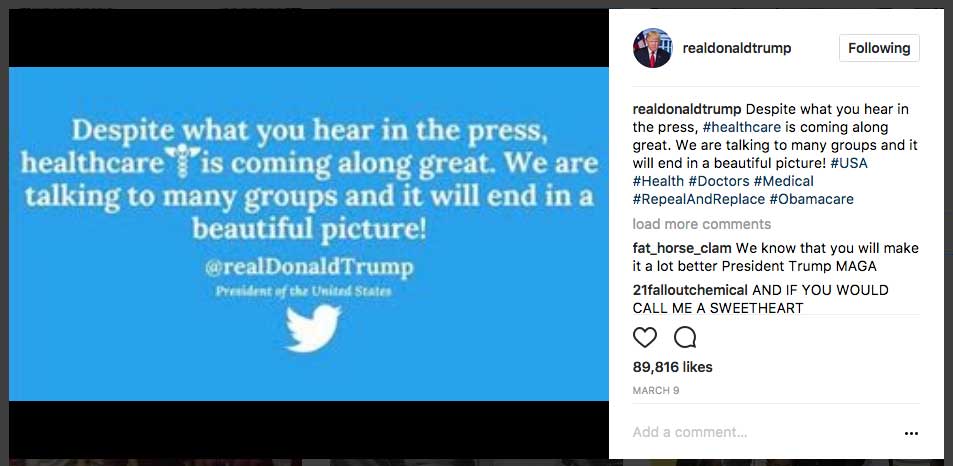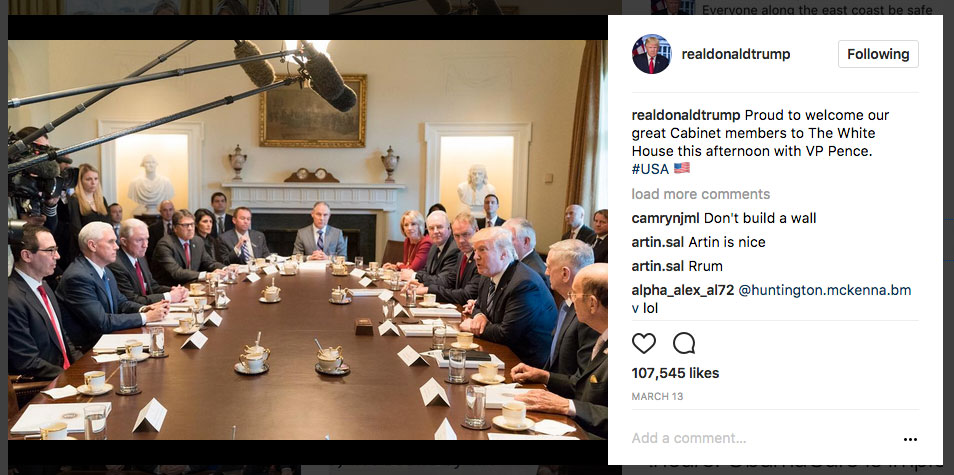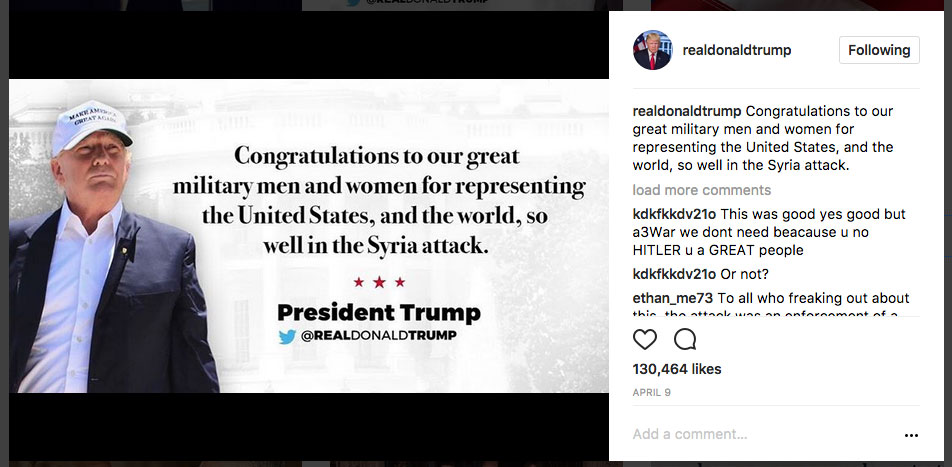Donald Trump’s presidency is riddled with provocations, missteps and radical interpretations of the presidential duties. To many, Trump’s political actions seem somewhat confusing, drastic and contradictory. The “Tweeter-in-chief”–as The New York Times’ Paul Krugman coined Trump–is considered to rely on “alternative facts” and on “deception, dissembling and exaggeration.” But to his followers he’s a very charismatic and authentic leader.
Trump’s alleged “straight-talk,” his authenticity, I assert, is in itself a rhetorical construct, that can and should be analyzed. This short essay wants to take a closer look at Trump’s visual-rhetorical strategies that align with his message of being a credible disruptor of the political status quo and a strong leader. Analyzing his official Instagram account, which is perhaps the contemporary equivalent of a propaganda poster wall, the essay seeks to deconstruct the making of Trump as an authentic powerful leader by combining the visual analytical instruments of semiology and visual rhetorics with aspects of discourse analysis.
Trump’s Instagram account @realdonaldtrump seems a bit of a Twitter clone. Trump and his communications team use Instagram as a second Twitter channel simply by putting the Twitter posts on Instagram. Sometimes the posts are just screenshots from the Twitter feed, recently accompanied by Twitter and Instagram logos. Sometimes these posts show the Twitter logo and the quote on a light blue background, and sometimes they layer the quote over Trump’s photograph, that itself is fading into the background. The president is photographed while texting on his mobile phone, presumably as he composes the very post people just read. Additionally, the caption next to the picture restates the exact same quote users see in the image. This twofold duplication certainly emphasizes Trump’s message and his way of breaking news to the public. But it also seems redundant and misplaced in terms of how Instagram as a digital platform works. Whereas other users sprinkle additional inspirational quotes into a stream of pictures to add to the construction of their personae, Trump’s political communication goes beyond this. By visually re-quoting his own tweets on Instagram, Trump to a certain degree ignores Instagram’s visual orientation and focus. Interestingly, this adds to Trump’s message of shaking up established ways of doing things.
Furthermore these Twitter posts on Instagram are telling in terms of Trump’s political self-understanding. For Trump, using Twitter/Instagram is more than a means of publicity or self-promotion, it is an ethos. By sending messages to his roughly 35 million Twitter followers and 7.2 million Instagram followers, Trump wants to directly address the people. By working with the social medium, he himself wants to work as a medium–an intermediary in the sense of the word–and bypass the traditional filters to which presidential communications have been subject. In his view, by questioning his actions, the mainstream media–time and time again defamed as ‘fake news’–deprives Trump of his presidential right to act as an embodiment of the people’s will. Social media on the other hand guarantees a direct line to the people to tell them what their will looks like in terms of political actions.
Take the Health Care Act, for instance. On March 9, 2017, Trump’s team reposted this tweet on Instagram (in a very poor pixel resolution): “Despite what you hear in the press, #healthcare is coming along great. We are talking to many groups and it will end in a beautiful picture!” It is more than curious that Trump portrays his future success of a revised healthcare bill as “a beautiful picture.” From his expression one can draw a conclusion: Trump translates his political success into an aesthetically pleasing and hence socially harmonic situation. Brutal and astonishing is not so much that Trump thinks his proposed healthcare bill is pleasing everyone when it would actually deprive millions of Americans of affordable coverage. His vision is also not that those Americans should get sick and die eventually, making space for his favorite citizens. What’s brutal and astonishing is that Trump is actually defining what’s in it for most of the Americans (in terms of healthcare, jobs, wages, etc.) and that once accomplished it can’t be anything else but a fit and hence beautiful. That is the innermost conviction of Trump and his followers, and it’s the reality of democratic leadership. Advocating for the “forgotten people” for Trump equates simply with strong leadership through defining what success is and what the people want. In Trump’s conviction it is his final saying, his tweet, if you will. And it’s the reason Trump appears compellingly authentic to his followers. “That the whole man should speak is authentic”, is what Theodor Adorno critically pointed out in his book The Jargon of Authenticity. Adorno understood that the jargon of authenticity appeals to an essential mode of existence and neglects criticism by transcending the content of the words spoken. By being authentic it is no longer important what you say, but that it is you who says it. The punchline is cynical: from a perspective of authenticity and authority, the more the president proclaims to be the strong leader the more he seems powerful and authentic, despite all his actions that work against the interests of those who voted for him.
Trump’s Instagram account fully proclaims and stages his true dedication to leadership and his authentic power. The essay now wants to focus on three recurring visual motifs on his Instagram account that underline and visually construct authentic leadership: (1) Trump sitting behind his desk in the Oval Office surrounded by a group of people, (2) Trump sitting at large tables with a lot of people and media, and (3) a series of staged images creating an archetypical presidential persona.
(1)
Many of the Instagram images depict Trump sitting behind his desk at the Oval Office in the White House surrounded by a group of people who literally stand behind him, smiling or watching him as he signs executive orders. The post from February 27, 2017, is a representative example and shows a crowd of twelve people, all men, all wearing black suits and some sort of tie. They form a visual shape that looks like a wall behind Trump who is the only one sitting behind his desk. The photograph seems like an amateur shot rather than a professional White House documentary photograph: the transoms of the windows in the background are tilted, the contrast between the dark suits and the light from outside is too stark, the exposure of the image is a bit too low and the reflection on the desk is very prominent and distracting. The picture looks like a hasty shot someone took during a group trip. In this regard the image denies any professionalism and thus to be a beautiful picture. This photo conveys that it is more important what these people did than how they look. Trump’s Instagram desk pictures don’t claim to be aesthetically pleasing or made to last, but rather to document the not yet materialized results of a successfully accomplished work alluding to force.
But what exactly did these people work on and who are they? The caption of this Instagram post provides some information. It is Trump who talks to us: “Great meeting with CEOs of leading U.S. health insurance companies who provide great healthcare to the American people.” The people behind Trump, who are not disclosed by their names, are in fact the same that profit from the healthcare system right now. And apparently they can make their concerns and voices heard. Two things are odd because they are missing, both in the picture and the caption. The American people, although evoked in Trump’s post, aren’t present in the photograph: it is the economic elite that negotiates with Trump. Furthermore, Trump doesn’t feel the urge to reveal what has been decided on behalf of the American people. What’s important to Trump’s message is the unity of those in power to define the fate of the American people. They all know that something “great” is coming along.
(2)
The second recurring form of images depict Trump sitting at a large round table in a conference room talking to decision makers and cabinet members. Like the previously discussed type of image, this composition shows the president in a working situation. The post from March 13, 2017, presents the president on the right side of the table and Vice President Mike Pence, Attorney General Jeff Sessions and Secretary of the Treasury Steven Mnuchin among others on the left. Only half of the picture is dedicated to the persons sitting at the table; the other half shows background and boom arms holding big microphones. The image is carefully composed visually, with the person seated at the end of the table situated in the exact center of the frame. The two busts in the background emphasize the static composition of the picture, which the massiveness of the table further underlines. Only the microphone boom arms add some dynamism to the image by jutting out diagonally. Everyone in this photograph is either directed towards or pays close attention to Donald Trump who in a visual demonstration of power holds his left wrist with his right hand. The caption on the right reads: “Proud to welcome our great Cabinet members to The White House this afternoon with VP Pence. #USA.”
What this post reveals is that Trump and his allegedly competent cabinet members are an attentive and solid group of people who were summoned by Trump to discuss political matters. And the press–although Trump doesn’t like it–attended the cabinet meeting to record and report. Beyond that, the image and caption remain void. In almost all of these images depicting Trump in meetings and roundtables, the specific political content is missing. What matters in Trump’s political communication is the mere image of a hard-working president and his staff who make “great” things happen. The images perfectly illustrate the difference between his aggressive agenda and its visual-rhetorical communication. The communication shifts away from any concrete political content towards an image of strong leadership and capable leaders who get “things” done. To consolidate this message with the viewer the Instagram account repeats the same kind of image over and over again, with slightly different angles and a different cast.
(3)
The third type of images discussed here–and there are many more additional kinds of repeated imagery on Trump’s Instagram–is some sort of collage, depicting the president and a quote of him. Some of them come with his core messages: “Make America Great Again” and “America First.” They swear the Instagram audience in on Trump’s message and they do it in a rather straightforward manner, showing just the president and his inspirational quote in bulk letters. A post from April 9, 2017, captures Trump from below wearing a suit, a white shirt without a tie, and a baseball hat with the words “Make America Great Again” stitched on it. In the background and through some digital haze one can make out the outlines of the White House, obscured in much the same way as Trump's political agenda. The angle at which Trump’s picture is taken suggests that he is someone to look up to. The missing tie indicates a certain hands-on mentality and his gaze looking at the horizon evokes dedication and a sense of oversight. On the right side Trump’s quote in a bold, serif typeface reads: “Congratulations to our great military men and women for representing the United States, and the world, so well in the Syria attack.” The quote is accompanied by something that appears to be a logo of the president on Instagram. It reads “President Trump” in a bold, sans-serif typeface and is separated from the quote by three red stars. Below this logo is the Twitter logo in blue and Trump’s Twitter account “@realdonaldtrump” in capital letters.
Altogether, the collage conveys an image of a supersized man in charge who–when it comes to military attacks–is a man with oversight, dedication and boldness. He’s advertised as someone who knows that everything he does–even deploying the military and bombing Syria–is for the greater good of the United States. In this regard, the collage is staging Trump as a dedicated doer and a brand name for action and national progress, a brand that is easily accessible via Twitter and that stands for the unity and rise of the country. Whatever the status quo of the political conflict with Syria is, or the position of the US administration and Trump on Assad or the final reason to bomb Syria, it all becomes secondary if not irrelevant to Trump’s message. The visual-rhetorical impact of the collage is what’s important. To show a man who successfully commands the country’s forces, driven by nothing less than his mandate to do right by the superpower and its people. It is in fact the mise-en-scène of an archetypical strong leader.
This image hews surprisingly closely to depictions of political power as we know them from historical propaganda posters. The hero leader shot from below to appear somewhat of monumental stature has also been used in political communication ranging from Chinese political posters to Leni Riefenstahl’s depictions of German athletes at the 1936 Berlin Olympiad. But the old-fashioned posters get a contemporary update. The strong leader is now approachable and partly cast aside for a message of true importance: it’s the great American people that give Trump his power and it’s the great American people that he commands. Like any other great propaganda the people is constantly evoked, but in this case rarely depicted. Because the great leader represents great power that coincides with his people’s will. And this is what Donald Trump promises and conveys to America on his Instagram account: a powerful definer of America’s will and fate–an authentic Donald Trump.








